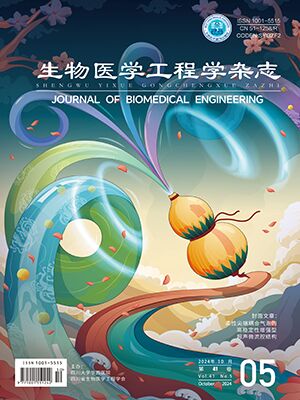| 1. |
Wilson R S, Segawa E, Boyle P A, et al. The natural history of cognitive decline in Alzheimer’s disease. Psychol Aging, 2012, 27(4): 1008-1017.
|
| 2. |
Jia Jianping, Wang Fen, Wei Cuibai, et al. The prevalence of dementia in urban and rural areas of China. Alzheimers Dement, 2014, 10(1): 1-9.
|
| 3. |
Jack C R, Albert M S, Knopman D S, et al. Introduction to the recommendations from the National Institute on Aging-Alzheimer’s Association workgroups on diagnostic guidelines for Alzheimer’s disease. Alzheimers Dement, 2011, 7(3): 257-262.
|
| 4. |
Ramani A, Jensen J H, Helpern J A. Quantitative MR imaging in Alzheimer disease. Radiology, 2006, 241(1): 26-44.
|
| 5. |
Cuingnet R, Gerardin E, Tessieras J, et al. Automatic classification of patients with Alzheimer’s disease from structural MRI: a comparison of ten methods using the ADNI database. Neuroimage, 2011, 56(2): 766-781.
|
| 6. |
Falahati F, Westman E, Simmons A. Multivariate data analysis and machine learning in Alzheimer’s disease with a focus on structural magnetic resonance imaging. J Alzheimers Dis, 2014, 41(3): 685-708.
|
| 7. |
Jack C R, Barkhof F, Bernstein M A, et al. Steps to standardization and validation of hippocampal volumetry as a biomarker in clinical trials and diagnostic criterion for Alzheimer’s disease. Alzheimers Dement, 2011, 7(4): 474-485.
|
| 8. |
Hill D L G, Schwarz A J, Isaac M, et al. Coalition Against Major Diseases/European Medicines Agency biomarker qualification of hippocampal volume for enrichment of clinical trials in predementia stages of Alzheimer’s disease. Alzheimers Dement, 2014, 10(4): 421-429.
|
| 9. |
Poulin S P, Dautoff R, Morris J C, et al. Amygdala atrophy is prominent in early Alzheimer’s disease and relates to symptom severity. Psychiatry Research: Neuroimaging, 2011, 194(1): 7-13.
|
| 10. |
Tanabe J L, Amend D, Schuff N, et al. Tissue segmentation of the brain in Alzheimer disease. Am J Neuroradiol, 1997, 18(1): 115-123.
|
| 11. |
Singh V, Chertkow H, Lerch J P, et al. Spatial patterns of cortical thinning in mild cognitive impairment and Alzheimer’s disease. Brain, 2006, 129(11): 2885-2893.
|
| 12. |
Eskildsen S F, Coup P, Garca-Lorenzo D, et al. For the Alzheimer’s Disease Neuroimaging Initiative Prediction of Alzheimer’s disease in subjects with mild cognitive impairment from the ADNI cohort using patterns of cortical thinning. Neuroimage, 2013, 65: 511-521.
|
| 13. |
Gerardin E, Chételat G, Chupin M, et al. Multidimensional classification of hippocampal shape features discriminates Alzheimer’s disease and mild cognitive impairment from normal aging. Neuroimage, 2009, 47(4): 1476-1486.
|
| 14. |
Achterberg H C, van der Lijn F, den Heijer T A, et al. Hippocampal shape is predictive for the development of dementia in a normal, elderly population. Hum Brain Mapp, 2014, 35(5): 2359-2371.
|
| 15. |
Chincarini A, Bosco P, Calvini P, et al. Local MRI analysis approach in the diagnosis of early and prodromal Alzheimer’s disease. Neuroimage, 2011, 58(2): 469-480.
|
| 16. |
Sorensen L, Igel C, Hansen N L, et al. Early detection of Alzheimer’s disease using MRI hippocampal texture. Hum Brain Mapp, 2016, 37(3): 1148-1161.
|
| 17. |
Lillemark L, Sorensen L, Pai A, et al. Brain region’s relative proximity as marker for Alzheimer’s disease based on structural MRI. BMC Med Imaging, 2014, 14(1): 21.
|
| 18. |
Klein S, Loog M, van der Lijn F, et al. Early diagnosis of dementia based on intersubject whole-brain dissimilarities//2010 IEEE International Symposium on Biomedical Imaging: From Nano to Macro. Rotterdam, Netherlands: IEEE, 2010: 249-252.
|
| 19. |
Braak H, Braak E. Neuropathological stageing of Alzheimer-related changes. Acta Neuropathol, 1991, 82(4): 239-259.
|
| 20. |
Colliot O, Chételat G, Chupin M, et al. Discrimination between Alzheimer disease, mild cognitive impairment, and normal aging by using automated segmentation of the hippocampus. Radiology, 2008, 248(1): 194-201.
|
| 21. |
胡玲静, 李昕, 夏翃, 等. 基于 MR 图像的阿尔茨海默病和轻度认知障碍患者海马三维纹理分析. 北京工业大学学报, 2012, 38(6): 942-948.
|
| 22. |
于鲁, 夏翃, 刘卫芳. 基于磁共振图像海马三维纹理特征的阿尔茨海默病及健康对照的分类研究. 生物医学工程学杂志, 2016, 33(6): 1090-1094.
|
| 23. |
Iglesias J E, Augustinack J C, Nguyen K, et al; Alzheimer’s Disease Neuroimaging Initiative. A computational atlas of the hippocampal formation using ex vivo, ultra-high resolution MRI: application to adaptive segmentation of in vivo MRI. NeuroImage, 2015, 115: 117-137.
|
| 24. |
Huang Guangbin, Zhou Hongming, Ding Xiaojian, et al. Extreme learning machine for regression and multiclass classification. IEEE Trans Syst Man Cybern B Cybern, 2012, 42(2): 513-529.
|
| 25. |
Rajeesh J. Automatic detection of alzheimers disease using hippocampus MRI texture features. Chennai: Anna University, 2011.
|
| 26. |
Li Xin, Xia Hong, Zhou Zhen, et al. 3D texture analysis of hippocampus based on MR images in patients with Alzheimer disease and mild cognitive impairment. J Beijing Univ Technol, 2012, 38(6): 942-948.
|
| 27. |
de Oliveira M S, Betting L E, Mory S B, et al. Texture analysis of magnetic resonance images of patients with juvenile myoclonic epilepsy. Epilepsy Behav, 2013, 27(1): 22-28.
|




